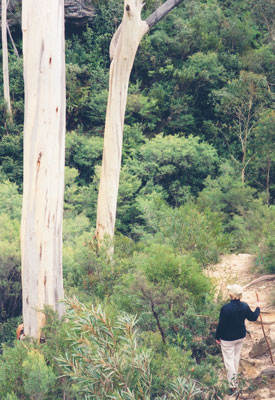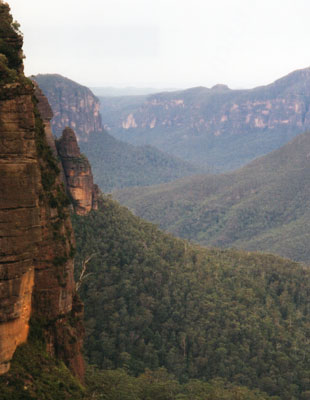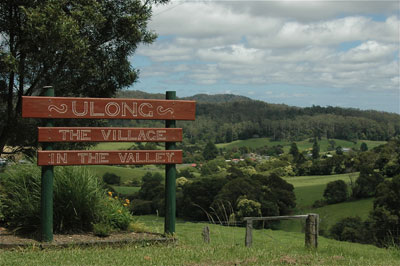Bushwalking in Australia
by Wendy Schatz, Bellevue, WA
Twice a year I visit Australia to update information for my US travel agency. My midyear trips coincide with fall and early winter Down Under, and I find this is the best season for hiking — or, as the Aussies prefer to say, bushwalking.
Hiking season
The Australian bush is full of colorful and sometimes noisy birds, flowers that bloom throughout the year and forests that range from moist jungle to dry-land savannah, all surrounded by scenery reminiscent of America’s Appalachian Mountains.
The best time to go depends on where you plan to go. March and April are ideal for Tasmania, and April through June is best for Victoria, the national parks around Perth and the Snowy Mountains near Canberra.
The farther north you go, the later in the season you should plan to visit. May through July is best for the Blue Mountains near Sydney and the northern half of New South Wales as well as southern Queensland. In the tropical north, June through August is a good time.
Not only do fall and winter offer the most pleasant hiking weather, insects are also scarce then and the creepy crawlies are hibernating.
Tours
If you are not comfortable driving on the left side of the road or navigating back roads on your own, there are a number of tour operators who offer guided bushwalks.
International Parktours (Queensland; phone +61 7 55333583, www.parktours.com.au) guides hikes in some of the popular national parks.
Tasmanian Wilderness Experiences (Tasmania; phone +03 6261 4971, www.twe.travel) concentrates on that rugged island, offering everything from day hikes to backpacking.
Hinterland Tours (New South Wales; phone +612 6655 2957, www.hinterlandtour.com.au) leads bushwalks throughout northern New South Wales, including the area described in this article. Hinterland emphasizes rainforest interpretation for both English- and German-speaking travelers. All these operators provide good introductions to the Australian bush.
I grew up in Australia, but I was a city and beach girl. My American husband is more familiar with the outdoors, so he introduced both of us to bushwalking in Australia.
For anyone willing to leave the tourist-beaten paths, hiking in Australia is similar to hiking in America, with the added delight of discovering a completely different natural world. My husband likes to say that a visit to the Australian bush, which hosts relic plants and animals from ancient Gondwanaland, is like a walk through Jurassic Park.
Dorrigo country
In July ’08 we had our first chance to explore the mountains inland from Coffs Harbour, a regional city in northern New South Wales. Well away from major urban areas, this scenic area is full of rainforests and waterfalls, with trees as big as redwoods and trails we had mostly to ourselves.
We used the town of Dorrigo as our base. Even though it boasts fewer than 2,000 residents, like many Australian country towns, Dorrigo has an array of cafés, shops, groceries and banks plus a post office and a pub.
We stayed at Lookout Motor Inn (Maynard Plains Rd., Dorrigo, NSW 2453; phone 612 6657 2511), 10 minutes west of town on Route 78. A modern motel with a restaurant of its own, Lookout Motor Inn, as its name implies, sits near the rim at the top of the mountain and enjoys panoramic views. Rooms run AU$79-$99 (US$51-$64) per night.
The Great Dividing Range, as it is called, parallels Australia’s east coast. It is rugged and steep on its ocean-facing side. On its inland side, the range slopes away gradually. In between is a rolling plateau three to four thousand feet high dissected by streams that plunge off the escarpment in misty and sometimes mighty waterfalls and then wind down deep chasms toward the sea.
For an overview of this region, one of our first visits was to the Rainforest Centre of Dorrigo National Park, located on a well-marked side road between our motel and town. This is the main education/information center for the World Heritage Gondwana Rainforests of Australia. Open every day (except Christmas) from 9 a.m. to 4:30 p.m., it is staffed by professional information officers.
The center’s displays give a good introduction to the region’s flora and fauna. It is also one of several places around Dorrigo where you can pick up free local maps.
The center’s most popular attraction is its Skywalk, which starts behind the center at the edge of a dropoff. This elevated walkway extends out through the trees to a point where visitors can look down on the forest canopy and out across a deep valley to the shimmering South Pacific, 35 kilometers away.
Later, we drove beyond the center to a trailhead, also in Dorrigo National Park. Following the Rosewood Creek circuit, we walked a 3-mile loop through native forests that took us past a massive, thousand-year-old blackbutt gum tree; above a waterfall that we could hear but not see through the trees; along Rosewood Creek, and back to our car.
For an added treat, an elusive and exquisite lyrebird ran across the road in front of us.
New national parks
Older maps show most of this region as state forests, which are generally managed for timber production. Some logging still occurs, but we were pleased to learn that the New South Wales state government has converted the best part of these forests into a series of national parks and reserves. They now bear names such as Bindarri, Chaelundi and Nymboi-Binderay, commemorating Aboriginal tribes who still have sacred sites in these hills.
These parks are mostly undeveloped. Parts of them are designed to remain wild. A few roads, some unpaved, allowed us to explore this wooded country and take side excursions to places like the Red Cedar Track, which circles through a stand of red cedars that look nothing like their North American namesakes, and Platypus Flat in a canyon beside the Nymboida River, where you may glimpse a platypus, turtle or even the endangered eastern freshwater cod.
Then there is Norman Jolly Memorial Grove, a stand of giant 800-year-old tallowwoods named after an early forester. Along the way, we admired the tall straight blue gums with their smooth white trunks, one of the most handsome trees in the world.
We kept listening for a kookaburra or cockatoo and were on the lookout for koalas, wombats and forest kangaroos. All of them are native here and we had heard or seen them before, but on this day a squawking flock of cockatoos was the only thing that revealed its presence.
Backpacking
Most trails, or “tracks” as locals often call them, are short enough for hikers to sample several in a day. Backpackers may be more interested in such long-range trails as the Bicentennial National Trail, running north-south along the Great Dividing Range, or the Bibbulmun Track, its counterpart in Western Australia.
The Australian Alps Track — which winds through the highest peaks of Victoria and through the Australian Capital Territory and southern New South Wales — has a string of overnight huts for long-distance hikers.
The most scenic and rugged country that Australia has to offer is in the mountains along the roadless south coast of Tasmania. As much as I would love to see it, it is a bit rough for a day hiker like me.
But I do not despair, for there are still hundreds of other bushwalks waiting for me to discover and explore them in Australia.
I will be happy to answer any reader’s questions e-mailed c/o ITN.




